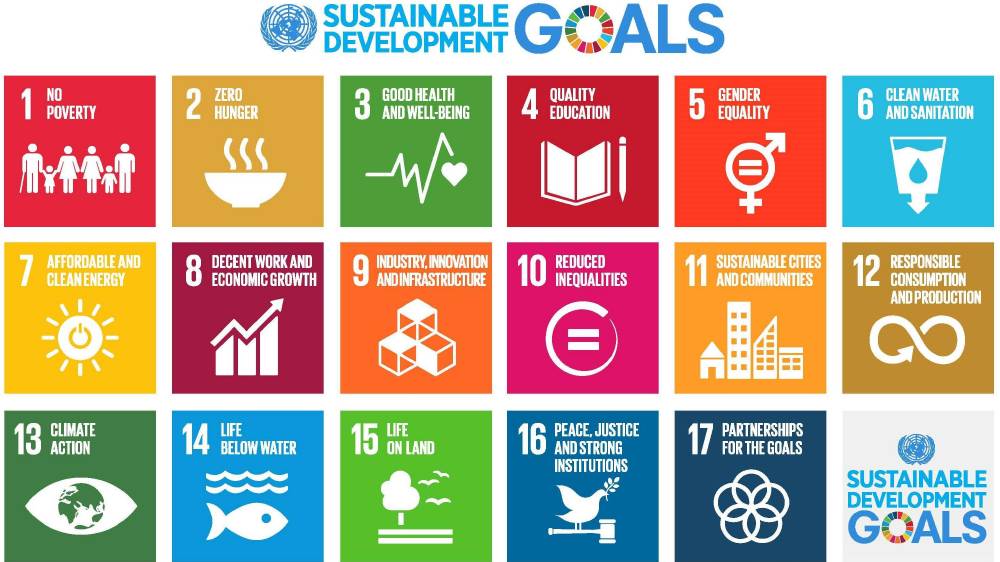The Sustainable Development Goals or Global Goals are a collection of 17 interlinked global goals designed to be a “blueprint to achieve a better and more sustainable future for all”. The SDGs were set in 2015 by the United Nations General Assembly and are intended to be achieved by the year 2030.
17 goals to be achieved:
- No Poverty Goal 1 calls for an end to poverty in all its manifestations by 2030. It also aims to ensure social protection for the poor and vulnerable, increase access to basic services and support people harmed by climate-related extreme events and other economic, social and environmental shocks and disasters
- Zero Hunger Goal 2 seeks sustainable solutions to end hunger in all its forms by 2030 and to achieve food security. The aim is to ensure that everyone everywhere has enough good-quality food to lead a healthy life. Achieving this Goal will require better access to food and the widespread promotion of sustainable agriculture.
- Good Health and Well-being SDG 3 aims to achieve universal health coverage, that seeks equitable access of healthcare services to all men and women. It proposes to end the preventable death of newborns, infants and children under 5 (child mortality) and end epidemics.
- Quality Education SDG 4 aims to provide children and young people with quality and easily accessible education plus other learning opportunities. One of its targets is to achieve universal literacy and numeracy. A major component in acquiring knowledge and valuable skills is the learning environment. Hence, the urgent need to build more educational facilities and also upgrade the present ones to provide safe, inclusive and effective learning environments for all.
- Gender Equality SDG 5 aims to grant women and girls equal rights, opportunities to live free without discrimination including workplace discrimination or any violence. This is to achieve gender equality and empower all women and girls.
- Clean Water and Sanitation Sustainable management of water resources and access to safe water and sanitation are essential for unlocking economic growth and productivity, and provide significant leverage for existing investments in health and education.
- Affordable and Clean Energy, Goal 7 of the SDGs aims to correct this enormous imbalance by ensuring everyone has access to affordable, reliable, and modern energy services by the year 2030. To expand energy access, it is crucial to enhance energy efficiency and to invest in renewable energy.
- Decent Work and Economic Growth This goal aims at ensuring the economic sector of every country provides the necessary need for its citizen to have a good life irrespective of their background, race or culture.[3] Roughly half the world’s population still lives on the equivalent of about US$2 a day. Besides, in too many places, having a job does not guarantee the ability to escape from poverty. This slow and uneven progress requires everyone to rethink and retool the economic and social policies aimed at eradicating poverty.
- Industry, Innovation and Infrastructure SDG 9 aims to build resilient infrastructure, promote sustainable industrialization and foster innovation.
- Reducing Inequality Goal 10 calls for reducing inequalities in income as well as those based on age, sex, disability, race, ethnicity, origin, religion or economic or other status within a country. The Goal also addresses inequalities among countries, including those related to representation, migration and development assistance.
- Sustainable Cities and Communities, SDG 11 aims to renew and plan cities and other human settlements in a way that offers opportunities for all, with access to basic services, energy, housing, transportation and green public spaces, while reducing resource use and environmental impact
- Responsible Consumption and Production SDG 12 is instrumental for reconciling economic, social and environmental objectives and decoupling greenhouse gas emissions (GHG) from economic growth. For sustainable transport solutions, the principles of SCP, such as resource efficiency, are of utmost importance for the transport sector.
- Climate Action The goal aims to mobilize US$100 billion annually by 2020 to address the needs of developing countries to both adapt to climate change and invest in low-carbon development. Supporting vulnerable regions will directly contribute not only to Goal 13 but also to the other SDGs.
- Life Below Water SDG 14 targets seek to prevent and reduce marine pollution; further the sustainable management and protection of marine and coastal ecosystems; address the impacts of ocean acidification; regulate harvesting and end overfishing, illegal, unreported and unregulated fishing and destructive fishing practices; conserve coastal and marine areas; increase the economic benefits to small island developing States and least developed countries from the sustainable use of marine resources; and strengthen the means of implementation, including increasing scientific knowledge, the transfer of marine technology and implementation of international law as reflected in the 1982 United Nations Convention on the Law of the Sea (UNCLOS).
- Life On Land Goal 15 focuses specifically on managing forests sustainably, restoring degraded lands and successfully combating desertification, reducing degraded natural habitats and ending biodiversity loss.
- Peace, Justice, and Strong Institutions Significantly reduce all forms of violence and related death rates everywhere. End abuse, exploitation, trafficking and all forms of violence against and torture of children. Promote the rule of law at the national and international levels and ensure equal access to justice for all.
- Partnerships for the Goals Coordinating policies to help developing countries manage their debt, as well as promoting investment for the least developed, is vital for sustainable growth and development. The goals aim to enhance North-South and South-South cooperation by supporting national plans to achieve all the targets.
Source: Wikipedia and UN website
- নাজিয়া তাসনিমhttps://www.thepapyrus.org/author/%e0%a6%a8%e0%a6%be%e0%a6%9c%e0%a6%bf%e0%a6%af%e0%a6%bc%e0%a6%be-%e0%a6%a4%e0%a6%be%e0%a6%b8%e0%a6%a8%e0%a6%bf%e0%a6%ae/বৃহস্পতিবার, জুন ১১, ২০২০
- নাজিয়া তাসনিমhttps://www.thepapyrus.org/author/%e0%a6%a8%e0%a6%be%e0%a6%9c%e0%a6%bf%e0%a6%af%e0%a6%bc%e0%a6%be-%e0%a6%a4%e0%a6%be%e0%a6%b8%e0%a6%a8%e0%a6%bf%e0%a6%ae/বৃহস্পতিবার, জুলাই ৯, ২০২০
- নাজিয়া তাসনিমhttps://www.thepapyrus.org/author/%e0%a6%a8%e0%a6%be%e0%a6%9c%e0%a6%bf%e0%a6%af%e0%a6%bc%e0%a6%be-%e0%a6%a4%e0%a6%be%e0%a6%b8%e0%a6%a8%e0%a6%bf%e0%a6%ae/বৃহস্পতিবার, আগস্ট ১৩, ২০২০
- নাজিয়া তাসনিমhttps://www.thepapyrus.org/author/%e0%a6%a8%e0%a6%be%e0%a6%9c%e0%a6%bf%e0%a6%af%e0%a6%bc%e0%a6%be-%e0%a6%a4%e0%a6%be%e0%a6%b8%e0%a6%a8%e0%a6%bf%e0%a6%ae/বৃহস্পতিবার, অক্টোবর ৮, ২০২০
- নাজিয়া তাসনিমhttps://www.thepapyrus.org/author/%e0%a6%a8%e0%a6%be%e0%a6%9c%e0%a6%bf%e0%a6%af%e0%a6%bc%e0%a6%be-%e0%a6%a4%e0%a6%be%e0%a6%b8%e0%a6%a8%e0%a6%bf%e0%a6%ae/বৃহস্পতিবার, নভেম্বর ১২, ২০২০











